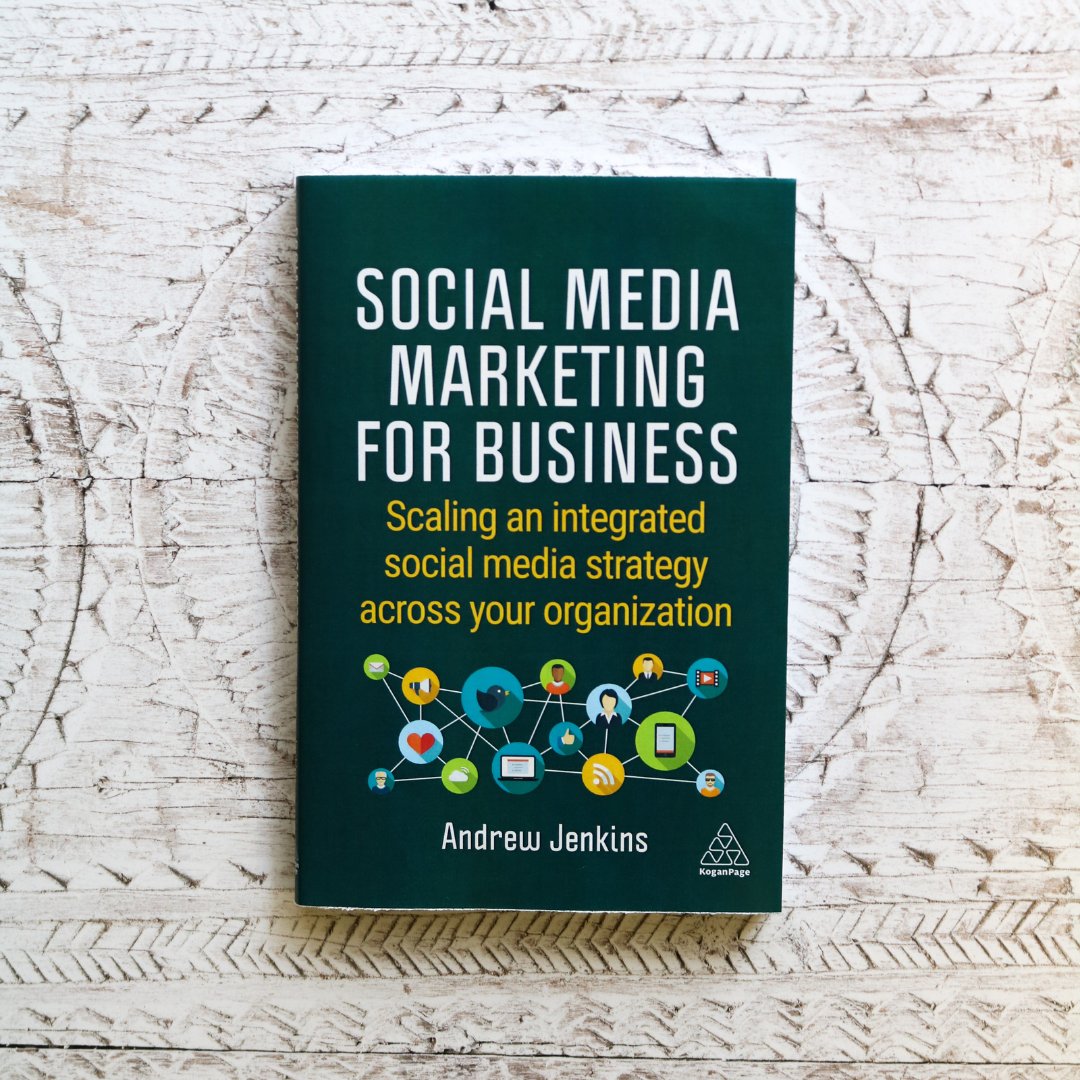Social media marketing in 2022: an interview with Andrew Jenkins

Article summary
In this interview, we talk to Andrew Jenkins, the founder of Volterra social media marketing agency, about social media in 2022. We discuss choosing a platform to focus on, planning a content strategy, and helpful tools to automate your marketing.
Listen to this interview!
Anna: Andrew, could you introduce yourself to our readers?
Andrew: My name is Andrew Jenkins. I have a company called Volterra. We specialize in outsourced social media management and social media strategy.
I also teach social media strategy at the University of Toronto, and I have just authored a book, Social Media Marketing for Business: Scaling Social Media Across Your Organization.
Social media marketing in 2022
Anna: I'm really excited to talk to someone who has so much experience with this topic!
We collaborated with Volterra on a case study a couple of years ago, and I think that the social media landscape has changed quite a bit since then. What are the services that businesses need nowadays the most from social media agencies? What kind of social media direction do they choose?
Andrew: Well, the first thing is the rise of video and just richer media. Whether it's through an agency or the organization themselves, they've got to focus on having more rich media that's more visually engaging as well.
For example, I wrote a blog post. We share it on social. Then we make it into a podcast, and we share it as well. We do a YouTube interview. You have to squeeze as much juice from the lemon as possible.
So if you go to the trouble of creating a core asset, a blog post, a video, or an interview, ask yourself what can be done with that core asset.
So I'll have the master profile, which is the full interview. But then I can parse it into more snackable video, more snackable audio clips, and some teaser content to basically introduce people to in a short clip that I can distribute across a variety of social channels and then give them the option to watch or listen to the full episode.
If the discussion was about five tools for B2B marketing or whatever, then that could be a listicle that could become an infographic and suddenly the foundational asset that was the interview becomes twelve different pieces of content.
By signing up I agree to the Terms of Use and Privacy Policy
And I didn't have to make six or twelve distinct and original pieces of content. I'm working smarter rather than harder.
As much as blogging is an integral part of marketing, it's changed. People are not reading blogs as much as they used to. Now there are AI tools that will read the blog for you in a lovely British accent if you want that.
It's not just about rich media, it's also addressing the consumption preferences. Some people want to read, some people want to listen. There are AI tools that will turn a blog into a video and it'll present the text to you in an animated way. So, lots of options.
Anna: So, why did you decide to write the book? Why did you decide that your knowledge and experience will be shared best in this way?

Andrew: Well, the writing of the book, albeit challenging, was made easier by the fact that many of the things discussed in the book I had written about or talked about.
You mentioned the case study with Awario, that was incorporated and I could add or update the results of the case study.
By signing up I agree to the Terms of Use and Privacy Policy
There are quite a few social media marketing books available, and my book does speak to social media marketing. But there are not many books for someone who finds themselves in a social media role amid a larger organization to understand the dynamics of a larger enterprise. Things like developing a social media policy, internal stakeholder management workflow, content planning across teams, business units, and all the many complexities that come with a larger organization.
It's not the sexiest part of social media or the cool parts, however, it's necessary. So the book is intended to be a bit of a handbook, somewhat prescriptive or kind of step-by-step instructions. It gives a sense of working with legal or HR or compliance if you're in a regulated industry like financial services or Pharma or healthcare which has its specific nuances or complexities that some other industries like consumer package goods or companies don't have to deal with it.
Anna: I think as social media marketers, we often have to learn from experience and when we come to a larger company or start working with a larger company it's kind of a trials and errors process. It's great to have some guidance in these matters.
Andrew: I've been teaching my course at the University of Toronto for eight years and before that, I was the head of social media for the World Bank of Canada, one of our largest banks.
The course I teach is in the school of continuing studies so all of my students are working professionals and the majority are coming from larger organizations like banks, pharmaceutical companies, insurance, healthcare, etc.
I hear from them directly about the challenges they face and as I was saying, it's not the cool part of social necessarily all the time. Yes, you get the fun part of creating content strategies and seeing campaigns succeed. But a lot of the time and energy is taken up with just stakeholder management making sure that potential policies are being properly developed, and properly adhered to.
Sadly, sometimes you have to deal with HR when someone has done on social something that they shouldn't have. It's not talked about much, but there's a lot of time and energy devoted to it. I call it policy and procedure that supports the execution of a social media strategy.
The first rule of social media marketing
Anna: Your book starts with the story of you setting up a Twitter account for the first time. You say that you made a typo in your very first week, and then your second tweet was complaining about the typo.
You then got a reply from your friend telling you just to relax and take it as it goes. It seems like at the very dawn of social media, being relaxed on social media was the best thing you could do. And I wonder, in 2022, what's the number one rule for social media?
Andrew: It's something that is easily said, but this idea of being human. All these social media pundits say we need to be more human and social. It's something easy to say, but it's hard to do.
Sometimes people in a large organization, maybe more corporate, are a little more serious and sort of buttoned-down. And I'll ask them something as simple as "Would you be allowed to say good morning on a Monday on your corporate account?"
Pretty innocuous kind of comment. And oftentimes they're just not accustomed to thinking that they can infuse some humanity into the social channels.
We need to think about the people behind those social accounts. We forget the fact that my relationship with the corporation is usually through people.
We need to think about the people behind those social accounts. We forget the fact that my relationship with the corporation is usually through people. It's not this static or inert thing that is this company or organization that I'm dealing with. I'm dealing with one or more people within it. And so this goes to the concept of employee advocacy. If I foster a culture that enables my employees to be more social on behalf of my organization and to be human and transparent, I succeed.
Of course, you need to be prepared if you're going to operate in social that you may be called out and judged by your corporate behavior. But if I can empower my employees to be more human on our behalf, within reason, and we can acknowledge that we're human, we're experiencing many of the same things, we can make it easier and better for each other to get through the week through our content.
However, there are many people within the realms of leadership that are like, "No, we push out our corporate messages". It's not even a conversation. It's just a one-way broadcast. We just keep pushing, pushing, pushing, and we hope people respond.
And I think there seems to be a point being missed there. It's called social media. We're not being social enough. We're certainly pushing media out, but we're not being social enough or as social as we could be as brands.
How to boost social media engagement
Anna: I know that Volterra focuses a lot on social media engagement. I wanted to ask you, are there any tips for brands to improve their social media and encourage social media engagement?
Andrew: Well, I think it sort of goes back to getting more value out of every piece of content.
Don't just look at social as checking a box. Sometimes when you create content be it a blog or a video, you just shared it once on Twitter or notify your subscribers and move on to the next episode. It's like checking the box. Okay, that was our assignment this week or this month or whatever, and then we move on to the next assignment.
Meanwhile, what are you doing to keep that piece of content in rotation? If it's still evergreen content, why isn't that in rotation? The shelf life of a tweet is less than 15 minutes. So that means I can tweet more times per day, more days per week, and I can actually repeat the content.
And the same thing with the way we consume content on Facebook and Instagram and Tik Tok and what have you.
This is why, if we have variations of our content still based on the same core asset, it gives me the freedom to kind of keep things in the rotation. Content is the beast that must be fed.
The biggest content marketing mistake brands make
Anna: Speaking about content, I wanted to ask you what would be the biggest or maybe the most common content marketing mistake that you see nowadays?
Andrew: Well, we talked about it earlier. Many are still in the mode of written content and I say this as someone who's written a book. But I'm treating the book as a foundational asset and there'll be content surrounding it. There will be some video content and things like that surrounding it.
Too many organizations are still too reliant on written content. I'm not here to dump on blogs, I've written numerous blogs and we still produce that kind of content for clients. But the key is not to stop there. Don't rely solely on, as I'll call it, your primary form of content.
Cisco's predicting in 2022, by the end of this year, 80% of content will be video. Look no further than TikTok. It's solely driven by video, user-generated, mind you.
The mistake being made by brands, and it's highlighted by TikTok, is that too much emphasis is placed on highly produced content.
The mistake being made by brands, and it's highlighted by TikTok, is that too much emphasis is placed on highly produced content.
Take a lesson from LinkedIn's TikTok account. One of their junior employees wearing a LinkedIn T-shirt, sitting on their couch in their own home recording a video on their phone that ends up on the LinkedIn corporate account.
Organizations and brands just need to be a little more relaxed.
Anna: I think sometimes brands might be afraid of this, like relaxed content and quick production and shipping because it might give more room for some kind of a controversial statement or misunderstanding. Any tips on how to safeguard yourself from this situation?
Andrew: I think if you're producing content of a lower production value, It just means you're less fussy. It's not an excuse to not be conscious of what you are producing, what's in it, what's the message, what's being said, what's being depicted, etc. I might have relaxed production value, but I'm not relaxing the oversight of my brand.
This is directly in Awario's wheelhouse: when we do social media listening and we're tracking sentiment, we have to do a deep dive and look at what's being said, what is truly a sentiment issue.
For example, we were doing some social media listening with your solution, and the company was referred to as the best-kept secret and the word secret triggered a negative sentiment label. Thankfully Awario can be taught so you can change the sentiment. But the thing is when it comes to sentiment and social media listening, you do have to look do some more granular analysis and look at it in proper context.

If you are seeing a trend or some consistent commentary that is trending and negative sentiment is high you need to start asking questions. What is the systemic issue underlying issue that might be causing that negative sentiment?
If I'm a telecom company and people are complaining about an outage or my toll for the customers, or the support phone line has ridiculous long wait times, those sorts of things, what are the underlying issues that might be causing that negative sentiment?
I'm trying to register for a webinar on my website or an e-commerce website keeps crashing because we've released a new product and the website is overwhelmed and people can't make the purchase or I'm selling concert tickets and they sold out in ten minutes, leaving thousands of people disappointed, that kind of thing.
So it's really like peeling the onion, looking at what negative sentiment posts have been accumulated, and then starting to sift through them to get the actionable insight.
How to keep up with social media trends
Anna: Social media is always changing, there are constantly new trends. I wanted to ask you, is it possible to establish some tactics or some tools to stay in the know all the time?
Andrew: I'll be the first one to say it's challenging to stay on top of everything.
Because of my teaching and because of the work that we do with clients, I have to stay on top as best I can. I use an app called Flipboard that enables me to scan different sources of content.
I mean, I've been on Twitter for 14 years as an example. I've watched that platform change dramatically. And every time someone says Twitter is over, you have the new trend coming. That's the channel that everyone goes to because it's real-time news.
I give that as an example. TikTok is five years old. It is now the most downloaded app. I don't know what the next new, bright, new, shiny thing is. Clubhouse was really hot a year and a half ago. Not so much anymore.
So you have to be careful. You need to be aware of something that's emerging, but you don't necessarily have to establish a presence there. Pay attention to it. See whether or not it's relevant to the audience that you want to serve. It may not be.
It goes back to something that I mentioned in the book - be careful of the "bright shiny syndrome".
It goes back to something that I mentioned in the book - be careful of the "bright shiny syndrome". There's that really cool new app or that cool new platform. Yeah, check it out. But don't feel that you have to establish a base camp there necessarily because you have to be careful.
You don't want to be a mile wide and a foot deep on ten different platforms when if you really took a step back and examined everything you see that 90% of our audiences are on three platforms. Every platform you establish yourself on has to be resourceful.
Social media marketing blitz
Anna: Now let's do the social media blitz! My first question is, what's the first website you open in the morning?
Andrew: Well, usually it's email, but in terms of content I open Flipboard, again.
Anna: The next question is: who should you follow on social media to learn social media marketing?
Andrew: Follow hashtags! For example, with #contentmarketing, you'll find Content Marketing Institute, Social Media Examiner, Social Media Today, Social Media Explorer, and Marketing Profits. Those are some good places to start.
Follow Awario! I'm not being facetious. Many of the technology companies on social, Volterra as well, share a lot of content that is valuable to our target audience. We're trying to be a resource to be helpful to educate, and indirectly that promotes our brand.
It goes back to the underlying philosophy of social media, which is to be social, to be helpful to be a resource. and to kind of pay it forward through content.
Anna: Next question. What would you choose Instagram reels or Tiktok?
Andrew: Hands down Tiktok.
Anna: I agree! Long-form content or short-form content?
Andrew: Well, it's funny because you're seeing content in both camps. It kind of works hand in hand and the short-form serves long-form content.
Look at people like Joe Rogan, you know, with a three-hour podcast, meanwhile, you can have the marketing school from Neil Patel, that's a six-minute episode. However, when we do analyze content through something like Buzzsumo, 1000 words or up are the pieces of content from a written form point of view that get the most engagement.
I think, all in all, people are appreciative of more substantive content where there's research and data.
Anna: Thank you for all the amazing insights! Where can our readers find your book and your expertise?
Andrew: I'm AJenkins on Twitter. You can find me on LinkedIn as well.
The corporate website Volterra Digital dot com. There's a link for my book there, but you can find my book on Amazon or Kogen. And, you know, Volterra Digital is on social as well, so, take your pick.













